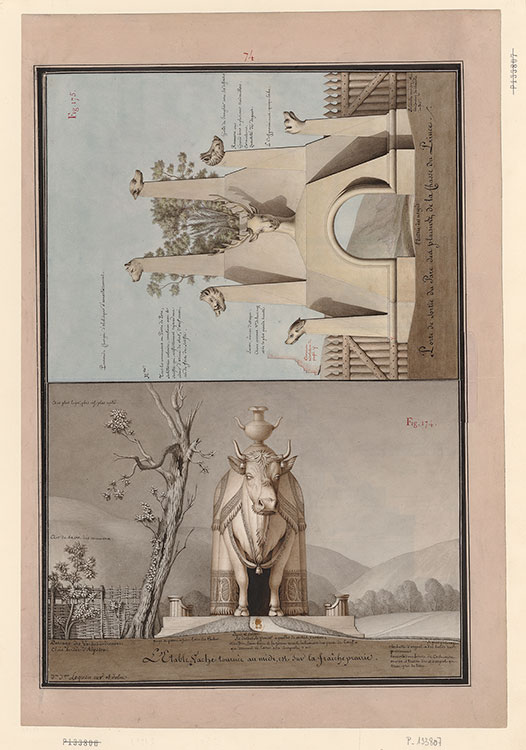
Lequeu tested the limits of architectural symbolism in these two designs where form follows function. The barn below is in the shape of a cow draped in a gold- and silver-studded Indian blanket. Its monumentalism and exotic connotations evoke the colossal plaster-and- wood elephant erected in the Place de la Bastille in Paris in 1813. The upper design depicts an entrance to a princely hunting reserve decorated with the heads of wild boar, deer, and hounds. It was intended to be sculpted in “pork stone,” a mix of limestone and sulfur that, according to the artist, diffused “an odor of cat urine . . . [or] rotten egg.”
Jean-Jacques Lequeu (1757–1826)
Cow Barn and Gate to the Hunting Grounds, from Civil Architecture, ca. 1815
Pen and black ink, brown and gray wash, watercolor
Bibliothèque nationale de France, Departement des Estampes et de la photographie
Jennifer Tonkovich: The term architecture parlante or speaking architecture, was coined in 1852 by the romantic architect Louis Boullée, to describe the works of one of Lequeu's neoclassical contemporaries, Claude Nicolas Ledoux. Speaking architecture is architecture whose form announces its function as this cow-shaped building reveals its role as a barn for cows, or as a roadside vegetable stand in the shape of a tomato, tells you what it's there for. The term was meant to be pejorative and reflects a later perspective on designs produced in the late 18th and early 19th century. While this design for a barn is highly inventive, it's also part of a larger effort by Lequeu's contemporaries to envision eccentrically shaped structures in the form of animals. This isn't as bizarre as it seems. In 1811, Napoleon envisioned a bronze elephant surrounded by a fountain and surmounted by a viewing platform at the center of the newly created, Place de la Bastille. The project advanced as far as having a full-scale plaster model installed in 1813. The bronze was never produced, but the plaster elephant stood for decades deteriorating in the weather. Lequeu's design participates in this wider effort to test the limits of unconventional structures.
